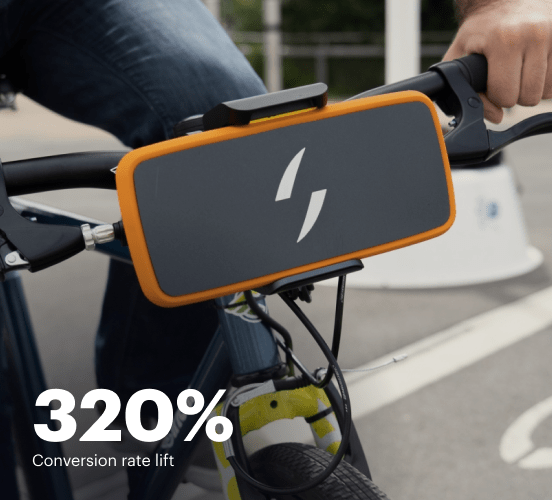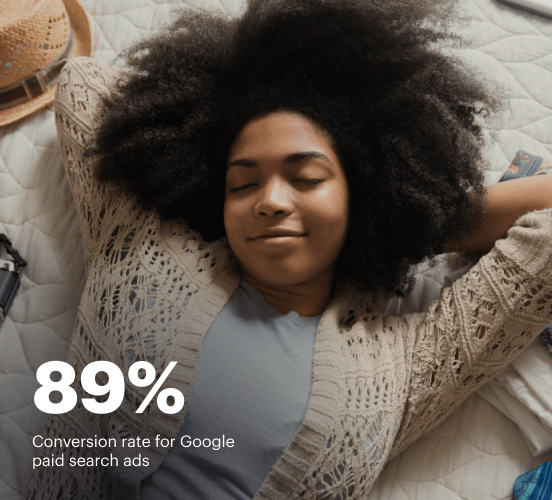How PageFly vs. Drupal vs. Instapage stack up against each other
Compare Instapage with PageFly and Drupal to create high-converting landing pages. With personalization, optimization, and collaboration tools, Instapage helps you deliver experiences that drive results.
Get startedSee how Instapage stacks up against the competition
| Feature | Instapage | Other builders |
| Drag-and-Drop Tools | ||
| Conversion-optimized templates | ||
| Manual and AI-powered A/B Tests | ||
| AI content suggestions | ||
| Popups and sticky bars | ||
| Canvas and grid blocks | ||
| Reusable and global elements | ||
| Form and popup builders | ||
| Built-in Heatmaps | ||
| Central analytics dashboard | ||
| Ad-to-page personalization and collections | ||
| Contacts, lists, and email | ||
| Dedicated, full-service CRO experts | ||
| Enterprise-ready platform |
Leading the way in building high-performing landing pages





Why Instapage is the smarter choice for your campaigns
Get everything you need to build, scale, and optimize high-converting landing pages—without coding.

Easier page building without coding
Instapage offers a flexible and seamless page creation experience with a library of 500+ conversion-focused layouts, Instablocks®, a drag-and-drop builder, and AI content generation. With technologies like Thor Render Engine®, you can create on-brand, mobile-responsive landing pages that load quickly and start converting during initial visitor clicks.

More insights — better results
Instapage lets you see in detail how each landing page experience and variation is performing so you can make targeted changes that boost page conversions. Use heatmaps for a better understanding of on-page activities, run A/B tests and AI-assisted experiments, and then track and evaluate results within robust analytics dashboards.

More personalized experiences
Instapage lets you quickly create high-performing landing pages tailored to each of your ad campaigns. Deliver personalized experiences for distinct audiences using dynamic text replacement. Effortlessly align specific advertisements to unique pages with AdMaps. Monitor audience-level metrics using our advanced data tools.

Built-in collaboration
Instapage collaboration capabilities bring your entire team together to speed up the process of landing page review, approval, and launch. No more frustrating and unnecessary revisions or edits scattered across emails. Provide instant feedback, conduct real-time page edits, and securely share your pages with outside stakeholders.

Free up time for your business
Invest time into business growth, not busy work. Launch landing pages faster with reusable forms and templates. Build once, reuse forever.
Explore all integrations






Easier page building without coding
Instapage offers a flexible and seamless page creation experience with a library of 500+ conversion-focused layouts, Instablocks®, a drag-and-drop builder, and AI content generation. With technologies like Thor Render Engine®, you can create on-brand, mobile-responsive landing pages that load quickly and start converting during initial visitor clicks.
More insights — better results
Instapage lets you see in detail how each landing page experience and variation is performing so you can make targeted changes that boost page conversions. Use heatmaps for a better understanding of on-page activities, run A/B tests and AI-assisted experiments, and then track and evaluate results within robust analytics dashboards.
More personalized experiences
Instapage lets you quickly create high-performing landing pages tailored to each of your ad campaigns. Deliver personalized experiences for distinct audiences using dynamic text replacement. Effortlessly align specific advertisements to unique pages with AdMaps. Monitor audience-level metrics using our advanced data tools.
Built-in collaboration
Instapage collaboration capabilities bring your entire team together to speed up the process of landing page review, approval, and launch. No more frustrating and unnecessary revisions or edits scattered across emails. Provide instant feedback, conduct real-time page edits, and securely share your pages with outside stakeholders.
Free up time for your business
Invest time into business growth, not busy work. Launch landing pages faster with reusable forms and templates. Build once, reuse forever.
Explore all integrationsGet started with Instapage in a few steps
-
Create your Instapage account
Start with Instapage by signing up via Google or your email. You'll get access to a free 14-day trial to discover Instapage capabilities. Feel free to cancel anytime during the 14-day trial if you decide that our product is not suitable for your business. -
Build and personalize your page
Create your first landing page from scratch or choose a template from 500+ customizable layouts. Use the drag-and-drop builder to add page elements, fonts, and backgrounds, refine content with AI, or add custom HTML, Javascript, and CSS. -
Review and make edits
Collaborate on page designs and streamline review processes. Invite your team members and stakeholders to review, edit, and provide feedback on your landing page. Collaborate knowing your page is confidential and only accessible to authorized users. -
Publish and track page performance
Publish your page to a domain or custom URL. Connect your pages to the ads you've created and track page performance within the analytics dashboard, run A/B tests and AI experiments, analyze results, and continuously optimize your landing page to maintain high conversions.
Instapage vs. PageFly vs. Drupal – Which Platform Shines Brightest?
Choosing the right landing page builder can feel a bit like assembling a dream team of superheroes for your marketing strategy. Each platform boasts unique strengths, similar to how different heroes have distinct powers. In this epic showdown, we will explore the capabilities of Instapage, PageFly, and Drupal, highlighting how they can help you engage audiences, reduce costs, and boost conversions. Instapage empowers marketers with tools designed to create relevant landing page experiences, fostering brand trust and customer loyalty while driving conversion rates skyward. So, whether you’re looking for customization, performance, or usability, this comparison will guide you towards your ideal platform, much like the perfect superhero squad. Let’s dive into the action! (min:200 words, add the small paragraphs in this paragraph.)
Meet the Contenders: A Quick Glimpse
In the left corner, we have Instapage, renowned for its incredible customization features and focus on conversion optimization. This platform caters to marketers seeking to craft personalized landing pages that resonate with their target audience. In the right corner, PageFly steps into the ring, a Shopify app that has captured the attention of e-commerce businesses worldwide. Known for its drag-and-drop simplicity, PageFly is a favorite among online store owners looking to build visually appealing pages without extensive coding knowledge. Lastly, we have Drupal, the robust content management system that is slightly more technical and complex, yet it offers unparalleled flexibility for users with programming know-how. Each contender brings a unique approach to landing page creation, making the fight for the title of best platform an exciting one. (min:200 words, add the small paragraphs in this paragraph.)
Round One: Feature Smackdown
Template Variety and User-Friendliness: A Close Comparison
When it comes to template variety and user-friendliness, each platform showcases its strengths. PageFly dazzles users with its extensive library of pre-designed templates that cater specifically to e-commerce, making it swift for merchants to launch campaigns. The drag-and-drop functionality simplifies the design process, ensuring that even the most inexperienced users can create stunning pages in no time. On the other side, Instapage boasts a library of over 500 customizable templates that adapt seamlessly to various industries. This extensive selection empowers marketers to create tailored experiences that align perfectly with their brand messaging. Drupal, while less focused on ready-made templates, offers unmatched flexibility, enabling developers to build unique page layouts with high customization potential. However, the learning curve may be steeper for beginners, as it requires a solid understanding of web development principles. In this round, both Instapage and PageFly stand out in terms of ease of use and variety, ultimately catering well to their respective target audiences. (min:200 words, add the small paragraphs in this paragraph.)
Instapage: Your Ultimate Partner in Customization and Conversion
Instapage shines with its suite of customization and conversion optimization tools that marketers simply can't overlook. With features like dynamic text replacement, A/B testing capabilities, and comprehensive analytics, Instapage ensures that every landing page is not just beautiful but also high-performing. The platform enables users to tweak every element, allowing marketers to create experiences that meet the particular needs of their audience. The ability to track user engagement and adapt strategies in real-time sets Instapage apart as not merely a tool, but a dedicated partner in the quest for success. The user-friendly interface and robust features combined with essential tools for performance monitoring make it an invaluable asset for those serious about boosting conversion rates. Marketers can rest easy knowing they have the resources to inspire brand loyalty and trust among their customers. (min:200 words)
Round Two: The Speed Race
Imagine this: you’re at your favorite coffee shop, but the line is moving painfully slow. The same frustration applies to your landing page's load times when users are waiting for content to appear. Speed and performance are crucial in today’s fast-paced digital world. Whether your users head to a landing page on their phone while waiting for their morning latte or at their desk during a break, you want them to have a smooth experience. Each platform has its strengths and weaknesses when it comes to speed. Let's see which contender earns the title of speed champion! (min:200 words, add the small paragraphs in this paragraph.)
Instapage Advantages:
- Instapage utilizes advanced caching technologies to ensure fast loading times, regardless of traffic.
- The platform automatically optimizes images and reduces file sizes to enhance speed.
- Designed with mobile optimization in mind, Instapage guarantees rapid performance across all devices.
- Load times are consistently low, helping to minimize bounce rates and keep visitors engaged.
PageFly Advantages:
- PageFly’s templates are well-optimized for performance, contributing to faster page rendering.
- The drag-and-drop interface allows for streamlined page creation without heavy coding.
- Built-in performance testing ensures compliance with speed standards during the design process.
Drupal Advantages:
- Drupal allows for extensive backend optimization, enabling developers to fine-tune speed settings.
- Customization options can lead to improved load times when efficiently configured.
- Caching modules can be implemented to ensure quick access to frequently requested content.
- It's scalable, allowing for fast performance even as websites grow in size.
In this speed showdown, Instapage takes the crown with its focus on delivering exceptionally fast landing page experiences that keep user engagement high. While PageFly and Drupal have their merits, Instapage's ability to seamlessly blend performance with rich features makes it the clear winner. Keep in mind that when swift loading times combine with effective design, you amplify the chances of better conversion rates. (min:200 words)
Third Round: Usability & Learning Curve
Navigating through any landing page builder shouldn’t feel like deciphering a complex puzzle. Each platform offers its own approach to usability, welcoming newcomers while providing tools for seasoned pros to refine their craft. Instapage boasts an intuitive design interface, ensuring users can jump in and start creating without an overwhelming learning curve. Its resource library further assists users in accessing best practices for successful landing pages. On the opposite spectrum, PageFly continues to be user-friendly primarily due to its drag-and-drop capabilities, making the design process enjoyable for those who might not have technical backgrounds. Conversely, Drupal can be likened to a powerful, somewhat intimidating wizard—fascinating but requiring some study to unlock its full potential. The learning curve can be steep, and users need a grasp of web development fundamentals to make the most of it. Overall, while each platform meets the needs of various user levels, Instapage and PageFly stand out in creating accessible experiences for newcomers while offering advanced functionalities. (min:200 words, add the small paragraphs in this paragraph.)
Round Four: The Support Crew
Imagine each platform’s customer support as loyal sidekicks, always ready to leap into action and assist users in their time of need. Instapage provides a solid support experience, offering live chat and a comprehensive knowledge base to address user queries quickly. Their dedicated success team can guide users through best practices to optimize their landing pages. PageFly's support is robust, with live chat options and extensive tutorials available to help users navigate obstacles during design. Conversely, Drupal takes a community-driven approach with vast forums, allowing users to engage and share solutions among a vibrant network of developers. While it may not offer personalized support as Instapage and PageFly, the community is an invaluable resource for troubleshooting. All three contenders have their unique support strengths, making it essential for users to evaluate which fits their support needs best. (min:200 words, add the small paragraphs in this paragraph.)
Round Five: The Pricing Perspective
Pricing structures often determine which platform stands out as the best fit for specific needs. Instapage offers a clear value proposition with its features tailored for marketers, though the pricing may be on the higher end. Still, the return on investment can often outweigh the costs due to increased conversion rates. PageFly comes in with competitive pricing, especially for e-commerce businesses, offering flexible plans that can grow as your store expands. This makes it appealing for startups that are just beginning their digital journey. Drupal, being open-source, allows for a potential cost-saving pathway, yet users must account for additional expenses related to hosting and development knowledge. Finding the right pricing model comes down to your unique situation, and readers should weigh their options carefully. (min:200 words)
In conclusion, every platform surfaces unique strengths, allowing users to define the best choice based on individual goals and requirements. While Instapage leads in customization, performance, and usability—a trio critical for marketers prioritizing conversion rates and brand loyalty—PageFly caters well to the e-commerce segment, and Drupal offers profound flexibility for experienced developers. It’s essential for readers to reflect on what they value most. For those seeking a free trial or demo, Instapage presents a perfect opportunity to explore its powerful capabilities, making it a fit for marketers looking to enhance their landing page strategy. (min:200 words)










